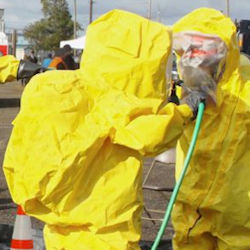Risk Factors in the Environment
Heat Stress
Externally generated heat in the workplace can cause an excessive total heat load on the body, which can result in heat stroke, a potentially life-threatening condition.
Heat exhaustion, heat cramps, dehydration, electrolyte imbalance, and loss of physical/mental work capacity can also result from heat stress.
Heat stress is made even more dangerous in the presence of high humidity due to the reduced ability of the body to cool itself.
Some common conditions that can bring on heat stress in employees include:
- Working in a hot environment, such as outdoors in direct sunlight, in a factory or warehouse without proper ventilation, or in a confined space with poor air circulation.
- Performing physically demanding work, such as heavy lifting or strenuous activity, in hot conditions.
- Wearing heavy or restrictive clothing or personal protective equipment (PPE) that can trap heat and prevent sweat from evaporating.
- Dehydration, which can occur if an employee is not drinking enough fluids to replace those lost through sweating.
- Certain medical conditions or medications that can make an employee more sensitive to heat.
- Working long hours or consecutive days without adequate rest breaks in a hot environment.
Knowledge Check Choose the best answer for the question.
4-1. Heat stress is made even more dangerous in the presence of _____.
You forgot to answer the question!


